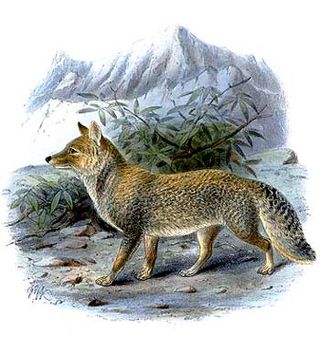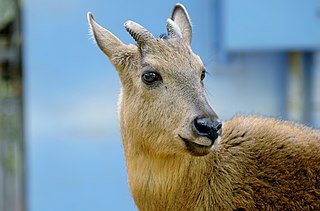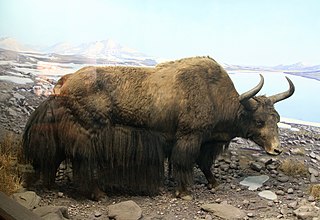
The bongo is a large, mostly nocturnal, forest-dwelling antelope, native to sub-Saharan Africa. Bongos are characterised by a striking reddish-brown coat, black and white markings, white-yellow stripes and long slightly spiralled horns. It is the only tragelaphid in which both sexes have horns. Bongos have a complex social interaction and are found in African dense forest mosaics. They are the third-largest antelope in the world.

The term antelope is used to refer to numerous species of the ruminant artiodactyl family Bovidae that are indigenous to most of Africa, India, the Middle East, Central Asia, and a small area of Eastern Europe. Antelopes do not form a monophyletic group, as some antelopes are more closely related to other bovid groups, like bovines, goats, and sheep, than to other antelopes.

The goa, also known as the Tibetan gazelle, is a species of antelope that inhabits the Tibetan plateau.

The subfamily Caprinae, also sometimes referred to as the tribe Caprini, is part of the ruminant family Bovidae, and consists of mostly medium-sized bovids. A member of this subfamily is called a caprine, or, more informally, a goat-antelope.

The Bovidae comprise the biological family of cloven-hoofed, ruminant mammals that includes cattle, yaks, bison, buffalo, antelopes, sheep and goats. A member of this family is called a bovid. With 143 extant species and 300 known extinct species, the family Bovidae consists of 11 major subfamilies and thirteen major tribes. The family evolved 20 million years ago, in the early Miocene.

Ladakh is a region administered by India as a union territory and constitutes an eastern portion of the larger Kashmir region that has been the subject of a dispute between India and Pakistan since 1947 and India and China since 1959. Ladakh is bordered by the Tibet Autonomous Region to the east, the Indian state of Himachal Pradesh to the south, both the Indian-administered union territory of Jammu and Kashmir and the Pakistan-administered Gilgit-Baltistan to the west, and the southwest corner of Xinjiang across the Karakoram Pass in the far north. It extends from the Siachen Glacier in the Karakoram range to the north to the main Great Himalayas to the south. The eastern end, consisting of the uninhabited Aksai Chin plains, is claimed by the Indian Government as part of Ladakh, and has been under Chinese control since 1962.

The hirola, also called the Hunter's hartebeest or Hunter's antelope, is a critically endangered antelope species found on the border between Kenya and Somalia. It was first described by the big game hunter and zoologist H.C.V. Hunter in 1888. It is the only living member of the genus Beatragus, though other species are known from the fossil record. The global hirola population is estimated at 300–500 animals and there are none in captivity. According to a document produced by the International Union for Conservation of Nature "the loss of the hirola would be the first extinction of a mammalian genus on mainland Africa in modern human history".

Shahtoosh, also known as Shatoush, is a wool obtained from the fur of the chiru. Also, shawls made from the wool of the chiru are called shahtoosh. Shahtoosh is the finest animal wool, followed by vicuña wool.

The Tibetan fox, also known as the Tibetan sand fox, is a species of true fox endemic to the high Tibetan Plateau, Ladakh plateau, Nepal, China, Sikkim, and Bhutan, up to elevations of about 5,300 m (17,400 ft). It is listed as Least Concern in the IUCN Red List, on account of its widespread range in the Tibetan Plateau's steppes and semi-deserts.

The flora and fauna of Ladakh was first studied by Ferdinand Stoliczka, an Austrian Czech palaeontologist, who carried out a massive expedition in the region in the 1870s. The fauna of Ladakh have much in common with that of Central Asia generally, and especially those of the Tibetan Plateau. An exception to this are the birds, many of which migrate from the warmer parts of India to spend the summer in Ladakh. For such an arid area, Ladakh has a great diversity of birds — 318 species have been recorded. Many of these birds reside or breed at high-altitude wetlands such as Tso Moriri.

The long-tailed goral or Amur goral is a species of ungulate of the family Bovidae found in the mountains of eastern and northern Asia, including Russia, China, and Korea. A population of this species exists in the Korean Demilitarized Zone, near the tracks of the Donghae Bukbu Line. The species is classified as endangered in South Korea, with an estimated population less than 250. It has been designated South Korean natural monument 217. In 2003, the species was reported as being present in Arunachal Pradesh, in northeast India.

Przewalski's gazelle is a member of the family Bovidae, and in the wild, is found only in China. Once widespread, its range has declined to six populations near Qinghai Lake. The gazelle was named after Nikolai Przhevalsky, a Russian explorer who collected a specimen and brought it back to St. Petersburg in 1875.

The red goral is a species of even-toed ungulate in the subfamily Caprinae in the family Bovidae. It is found in India, Tibet and Myanmar. Its natural habitats are seasonal mountainous areas 1,000 to 2,000 meters above sea level. It is threatened by habitat loss and hunting.
The Depsang Plains, a high-altitude gravelly plain in the northwest portion of the disputed Aksai Chin region of Kashmir, divided into Indian and Chinese administered portions by a Line of Actual Control. India controls the western portion of the plains as part of Ladakh, while the eastern portion is controlled by China and claimed by India. The Line of Control with Pakistan-administered Gilgit-Baltistan is 80 kilometres (50 mi) west of the Depsang Plains with the Siachen Glacier in-between. Ladakh's traditional trade route to Central Asia passed through the Depsang Plains, with the Karakoram Pass lying directly to its north.
Chang Tang National Nature Reserve lies in the northern Tibetan Plateau. It is the third-largest land nature reserve in the world, after the Northeast Greenland National Park and Kavango-Zambezi Transfrontier Conservation Area, with an area of over 334,000 km2 (129,000 sq mi), making it bigger than 183 countries. Administratively, it lies in Xainza County and Biru County of the Nagqu Prefecture. With the more recently established adjoining reserves listed below there is now a total of 496,000 km2 of connected Nature Reserves, which represents an area almost as large as Spain and bigger than 197 other countries.

The wild yak is a large, wild bovine native to the Himalayas. It is the ancestor of the domestic yak.

Bovidae in Chinese mythology include various myths and legends about a group of biologically distinct animals which form important motifs within Chinese mythology. There are many myths about the animals modernly classified as Bovidae, referring to oxen, sheep, goats, and mythological types such as "unicorns". Chinese mythology refers to those myths found in the historical geographic area of China, a geographic area which has evolved or changed somewhat through history. Thus this includes myths in Chinese and other languages, as transmitted by Han Chinese as well as other ethnic groups. There are various motifs of animals of the Bovidae biological family in Chinese mythology. These have often served as allusions in poetry and other literature. Some species are also used in the traditional Chinese calendar and time-keeping system.

Saigini is a tribe of artiodactyl mammals of the Bovidae family, subfamily Antilopinae, comprising two species of medium-sized antelopes that inhabit the Eurasian steppes.
Mycetocola zhujimingii is a Gram-positive, aerobic and short-rod-shaped bacterium from the genus Mycetocola which has been isolated from the faeces of the antelope Pantholops hodgsonii from the Qinghai-Tibet Plateau in China.





















